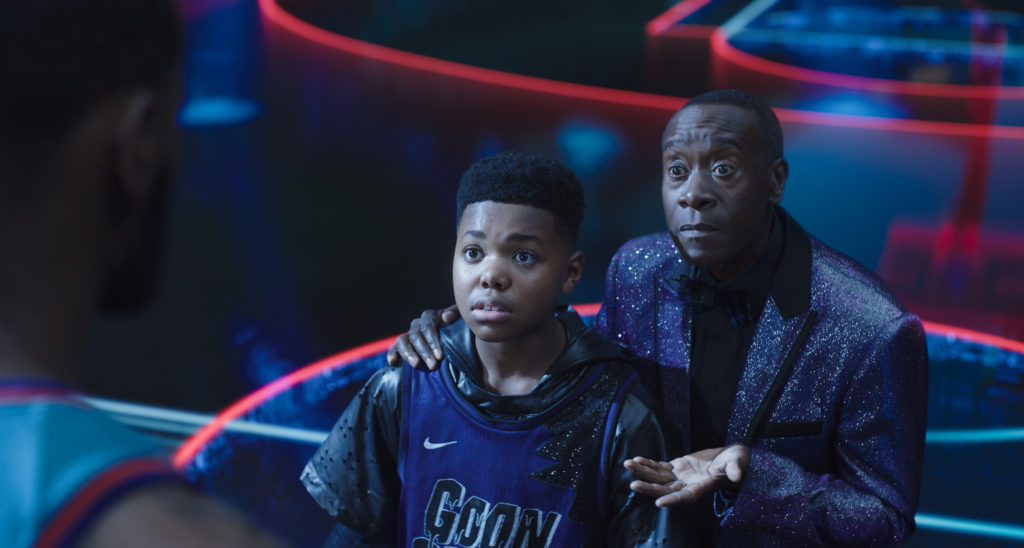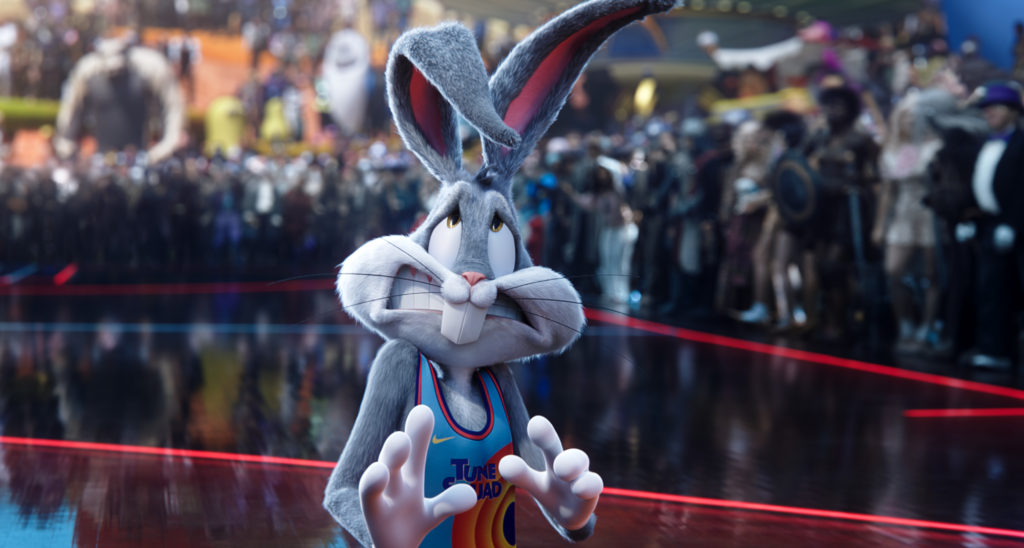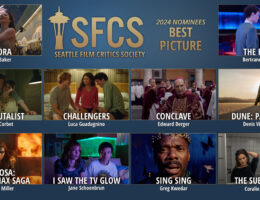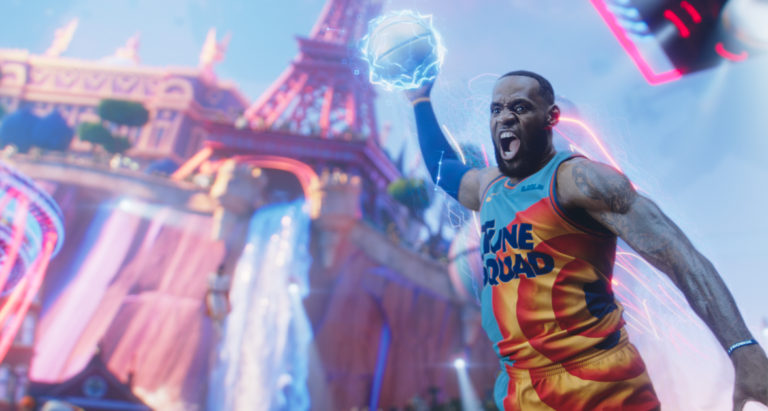Space Jam: A New Legacy (2021 | USA | 115 minutes | Malcolm D. Lee)
A film that only succeeds in dunking on itself over and over again, Space Jam: A New Legacy is a woefully misguided marketing ploy masquerading as a movie.
Cataloging everything that is completely disastrous and cynical about Space Jam: A New Legacy could fill an entire film of its own. Such a focus might actually make for an interesting documentary that dissects why, exactly, this was made in the way it was (or made at all). Alas, the film we have in front of ourselves today is the result of taking the least interesting and most contrived direction to a sequel to a 24-year-old comedy possible.
LeBron James plays a version of himself who is struggling to connect with his son Dom (Cedric Joe), a talented video game designer who his father doesn’t understand. The duo go to a meeting at Warner Bros. where they hear an algorithm-developed pitch about turning LeBron into a version of himself that could be put into all of the studio’s properties.
LeBron rejects the proposal, though father and son will soon be sucked into the world of the algorithm anyway. This is because the algorithm is actually a conscious being (“Al G. Rhythm”) who is so hurt over his rejected pitch that he decides to kidnap the family. Played by Don Cheadle, the only actor who is really laying it all out there, AI imprisons LeBron in a virtual realm and informs him that he will have to defeat him in a basketball game. If he loses, he will be trapped there with his son forever. Left with few options, LeBron must create a team of Looney Tunes or risk losing all he holds dear: his family.

It is on that journey that the film gradually begins to feel like brain rot with next to no creative ideas that aren’t based around film and television references. It quickly becomes clear that the movie is less of a sequel to Space Jam, which still has a prevailing charm despite its flaws, than it is a mechanism to force in as many references to Warner Bros. properties as possible. From trailers, it was already known that the climactic basketball game would have a crowd of familiar characters that were comical in how out of place they were. Throwing the context of the characters out the window, it was already a bizarre and borderline cringeworthy choice.
The film is far worse than this initial glimpse could have ever prepared us for.
LeBron journeys from world to world to gather the Tunes who have been scattered across a digital landscape that more closely resembles a theme park. The film strips the distinct characters from The Matrix to Rick and Morty of all their uniqueness in order to grind them into a corporate package to feed a greedy content assimilation machine. Various Looney Tunes have left their home world in order to pop up in other universes in what feel like hollow parodies (think Disaster Movie, Date Movie, etc.) where the reference itself to beloved films is the only joke. Repurposing these scenes verbatim is a closed loop of humor with nothing going on except self-promotion.
Certain uses of particular films, like Mad Max: Fury Road, are merely backdrops for brief cutaway scenes that feel like inside robbery jobs of other, more talented, directors’ ambitious visions. It somehow makes a film like 2018’s Ready Player One, which is the closest comparison in terms of sheer volume of references, feel almost nuanced and purposeful. Both do commit the grievous offense of using The Iron Giant, removing all of the meaning behind it in order to just have a cool robot. What makes it all so distasteful is that Space Jam: A New Legacy just throws all these references into a blender without any vision or thought. It all feels just so out of place and like the film is constantly selling out.

The film is also oblivious to its own major thematic hangup. LeBron initially refuses to participate in what is basically the entire premise of the movie — have a big name celebrity athlete interact with all of the Warner Bros. properties — and then gets trapped into it anyways in a deeply contrived manner. This juxtaposition is charitably meant to be some kind of self-aware acknowledgement, or perhaps if you are really stretching, a meta-commentary on the way the film plays out. However, none of this is successful in the slightest and only shows how flawed the idea was from the start.
Perhaps all this could be forgiven, after all this film is not the first to ever feel like a corporate advertisement, if the rest of the movie was itself funny. Not only is it not funny, all the jokes are repetitive and safe. The same jokes over and over lose any semblance of humor after a while. The film makes more jokes about LeBron’s basketball career than any other topic and just recycles this premise ad nauseam. It makes for a series of bits and sequences that always ring hollow. This isn’t helped by the fact that LeBron just can’t carry the role.
A knowing aside about athletes making for bad actors can’t hide just how out of his depth LeBron is as the lead of a comedy film such as this. While the writing doesn’t do him any favors, it just may be that he is not all that cut out for this. In past supporting roles, he has been surprisingly good. Here, he just flounders from scene to scene when he needs to be far sharper. This is only made all the worse when he is inexplicably turned into an animated character for a large portion of the film, undoing what fun remained of seeing a real person interact with cartoons. By no means was Michael Jordan an amazing actor in the original, though by comparison he now seems like a comedic genius. The fact that the film does a misdirect joke about Jordan making an appearance makes the big shoes he left to fill, both literally and figuratively, all the more glaringly apparent.

The visual presentation itself is also a huge problem. In the finale, the Tunes get an “upgrade” and become CGI monstrosities. The transformation renders them into lifeless recreations without any character or individuality. It ensures the film ends on a weird note, especially when the opposing team are a squad of famous basketball players rendered in uncanny valley animation mixed with yet more special effects that just look wrong no matter how long you’re stuck staring at them. The final showdown all just ends up being rotten icing on the stale cake of an incredibly misguided and misjudged sequel with nowhere to go.
Perhaps there will be some very young audiences who can overlook all these headaches and find some joy in it just as generations prior did with the original. That film was by no stretch of the imagination a masterpiece in any sense of the word, especially on a rewatch, though at least there was something fun about it. Space Jam: A New Legacy feels more like a chore than an entertaining film. The fundamental flaw is that it plays as a nearly two hour malaise of a corporate presentation that doubles as an advertisement for the Warner Bros. catalogue, none of which is used in any interesting way. That soulless core ensures that this film is not creating any type of “legacy” for itself, other than one of tepid and artless corporate slop.
You can watch Space Jam: A New Legacy in theaters and on HBO Max starting July 16.




